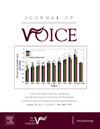不同准备指挥手势对合唱歌手呼吸行为和声音质量的影响
IF 2.5
4区 医学
Q1 AUDIOLOGY & SPEECH-LANGUAGE PATHOLOGY
引用次数: 0
摘要
目的呼吸技巧是歌手音质的决定性因素,因此对合唱音色至关重要。然而,人们对指挥的准备手势对合唱歌手在乐曲开始前(分别是随后的每个乐句)的吸气方式可能产生的影响知之甚少。指挥方面的文献并没有区分向外和向内的准备手势,甚至将它们等同起来,但以往的研究表明,歌手会将不同的吸气方式赋予不同的准备手势。因此,可以认为准备手势的类型对歌手的吸气和音质有直接影响,本研究的目的就是研究两种截然不同的准备手势对歌手的吸气类型和由此产生的音质可能产生的影响:我们采用被试内部研究设计,招募了 18 名健康的合唱歌手(9 男/9 女)参加实验室实验。实验要求参与者在不同的视频刺激下唱出适合自己音域的音调。这些视频包括两段指挥视频,每段视频都显示了不同的准备手势,以及两段对照条件视频,视频中的动画条和箭头显示了所需的呼吸类型。歌手们对 10 组视频做出反应,每组由随机顺序排列的四种刺激组成。为了评估不同实验条件下的呼吸行为和声音输出,通过三维运动捕捉测量了上肋骨、腹部肋骨和腹部的胸壁运动学,并记录了声音样本。对获得的数据进行筛选,并使用重复测量方差分析和事后 Tukey 检验对显著结果进行比较。显著性水平设定为 P <0.05:研究结果表明,两种不同的手势在腹部体积上存在显著差异(F1,17 = 24.04,η2 = 0.59,P = 0.0001),这可以通过两种对照测量得到验证(F1,17 = 21.12,η2 = 0.55,P = 0.0002)。向外的准备动作会引起腹式呼吸,而向内向上的动作则会导致锁骨呼吸比例较高的吸气。此外,产生的音色和音量也有明显差异。外向准备动作的最大声压级明显高于内向上动作(F1,17 = 20.4, η2 = 0.56, P = 0.0004):现有的指挥文献没有区分向外和向内的准备手势,与此不同的是,本研究的结果表明,指挥对准备手势的轨迹方向和形式的选择会引起歌唱者呼吸行为以及相应的响度和音质的自发的、特定的手势反应。本文章由计算机程序翻译,如有差异,请以英文原文为准。
The Effect of Different Preparatory Conducting Gestures on Breathing Behavior and Voice Quality of Choral Singers
Objective
The breathing technique is a determining factor for the singer's sound quality and consequently crucial for the choral sound. However, very little is known about possible influences of the conductor's preparatory gesture on the way choral singers inhale before the beginning of a piece (respectively every subsequent phrase). The conducting literature does not discriminate between out- and inward preparatory gestures and even describes them as equivalent, but previous studies suggest that singers assign different types of inhalation to different preparatory gestures. It may therefore be assumed that the type of preparatory gesture has a direct influence on the singer's inhalation and tone production, and the aim of this study is hence to examine possible effects of two contrasting preparatory gestures on the singer's inhalation type and the resulting tone quality.
Methods
In our within-subjects study design, 18 healthy choral singers (9 male/ 9 female) were recruited to participate in a laboratory experiment. The participants were asked to sing a tone suitable for their voice register in response to different video stimuli. These consisted of two conducting-videos, each showing a different preparatory gesture, and two control conditions with an animated bar and an arrow indicating the desired breathing type. The singers reacted to 10 sets of videos, each set consisting of the four stimuli in randomized order. For evaluation of the breathing behavior and vocal output during the different experimental conditions, chest wall kinematics of upper rib cage, abdominal rib cage and abdomen were measured via 3D motion capture and voice samples were recorded. The obtained data were filtered and compared using the repeated measures analysis of variance and post hoc Tukey test for significant results. The level of significance was set at P < 0.05.
Results
The results of the study show significant differences in volume of the abdomen between the two different gestures (F1,17 = 24.04, η2 = 0.59, P = 0.0001), which can be validated by the two control measurements (F1,17 = 21.12, η2 = 0.55, P = 0.0002). An outward preparatory gesture evoked an abdominal breathing type while an inward-upward movement led to an inhalation with a higher portion of clavicular breathing. Furthermore, significant differences in timbre and loudness of the produced tone could be observed. The maximum sound pressure level of the outward preparatory gesture was significantly higher than in case of the inward-upward movement (F1,17 = 20.4, η2 = 0.56, P = 0.0004).
Conclusions
In contrast to the existing conducting literature, which does not discriminate between out- and inward preparatory gestures, the results of this study show that the conductor's choice of trajectory direction and form of the preparatory gestures elicit spontaneous, gesture-specific reactions in singers’ breathing behavior as well as the corresponding loudness and sound quality.
求助全文
通过发布文献求助,成功后即可免费获取论文全文。
去求助
来源期刊

Journal of Voice
医学-耳鼻喉科学
CiteScore
4.00
自引率
13.60%
发文量
395
审稿时长
59 days
期刊介绍:
The Journal of Voice is widely regarded as the world''s premiere journal for voice medicine and research. This peer-reviewed publication is listed in Index Medicus and is indexed by the Institute for Scientific Information. The journal contains articles written by experts throughout the world on all topics in voice sciences, voice medicine and surgery, and speech-language pathologists'' management of voice-related problems. The journal includes clinical articles, clinical research, and laboratory research. Members of the Foundation receive the journal as a benefit of membership.
 求助内容:
求助内容: 应助结果提醒方式:
应助结果提醒方式:


